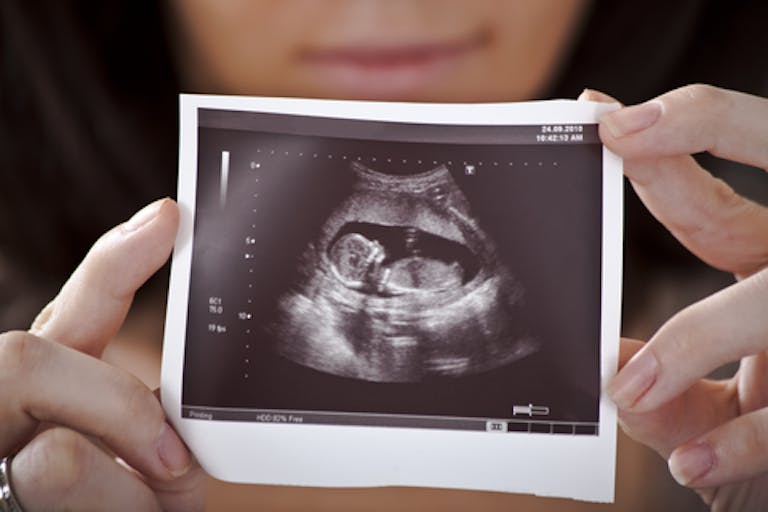
Research shows Catholic support for IVF declines once Church teaching is understood
Angeline Tan
·
Abortion records, ultrasounds and the truth
On January 9, Slate came out with an article about a study that was published in Obstetrics & Gynecology which addressed the question of whether or not women who viewed ultrasounds at abortion clinics were less likely to go through with the procedure. The study claimed that the vast majority (over 95%) of women who elected to see the sonogram (they had a choice whether or not to see it) chose to have abortions anyway.
This seems to fly in the face of everything that pro-lifers have experienced. Crisis pregnancy centers around the country have written about the difference that ultrasound makes. For example, the Washington Times published a survey done by pro-life crisis pregnancy centers that said that 20%-30% of the “abortion minded” women who came to them prior to their acquiring ultrasound machines chose to have their babies rather than have abortions. When the ultrasound machines were incorporated into the services the crisis pregnancy centers offered, that number skyrocketed to 80 – 90%.(1)
In a previous article of mine, Live Action presented some of the stories of women who chose life after seeing the pictures of their babies. There have been many, many cases of women whose minds were changed, as well as at least three cases of abortion providers – two clinic workers and one abortionist – who left the abortion business after seeing abortions on an ultrasound screen.
So why such disparity between these pro-life stories and this study done in a respected medical journal? Well, I did not conduct the study, but I do have a story to tell, which may or may not explain something.
One of my best friends, who died a little over a year ago, used to tell me about an experience she had which troubled her deeply. My friend’s illness had been a part of her life for very long time, and in those cold winter weeks, she knew – we both knew –that she did not have much time left. We spent hours together, both in the hospital and over the phone, trying to steal as much precious time as we could with one another before the inevitable happened. Sometimes we spoke. Sometimes we cried. Sometimes I just sat and watched her sleep, holding her hand. And we talked about many things.
There was something that was haunting my friend – something that had happened over ten years earlier.
In 2002 (two years before my friend and I reconnected after losing touch after high school) someone who I’ll call Emily asked her a favor. Emily was pregnant, and she and her boyfriend didn’t want the baby. Her boyfriend had to work; would my friend go with her to the abortion clinic? Wanting to be supportive, my friend drove her to the clinic and sat with her in the waiting room.
Emily was nervous and, although no visitors were allowed in the operating room, my friend accompanied her for the ultrasound.
“Okay,” said the clinic worker, as they wheeled the big ultrasound machine into the room. “We just have to print out a picture of the pregnancy. Legally, you’re supposed to view it – but don’t worry – we can take care of that.”
As she smeared jelly on Emily’s pregnant belly, they were careful to turn the screen away from Emily and, as it happened, towards my friend.
Article continues below
Dear Reader,
In 2026, Live Action is heading straight where the battle is fiercest: college campuses.
We have a bold initiative to establish 100 Live Action campus chapters within the next year, and your partnership will make it a success!
Your support today will help train and equip young leaders, bring Live Action’s educational content into academic environments, host on-campus events and debates, and empower students to challenge the pro-abortion status quo with truth and compassion.
Invest in pro-life grassroots outreach and cultural formation with your DOUBLED year-end gift!
What my friend saw on the screen, a fully formed baby at about eleven weeks, horrified her. She wanted to grab Emily and run out of there. But my friend could find no words to say. After all, the choice had been made; the abortion had been paid for, it was too late- wasn’t it? She just sat there and watched the unsuspecting child moving her arms around and kicking in Emily’s womb.
A printer switched on, and a clinic worker took the paper and wheeled the ultrasound machine away. Moments later, she came back with Emily’s chart, with the ultrasound printout stapled to a sheet for Emily to sign at the bottom. The clinic worker handed Emily the printed out ultrasound picture – with a big index card taped over the picture of the baby, so that Emily could not see it.
Emily dutifully signed the sheet below the taped-over picture verifying that she had seen the ultrasound and chose to abort anyway. My friend wanted to talk to Emily, but the clinic workers didn’t leave them alone. They ushered my friend back into the waiting room and wheeled Emily into surgery. Everything was moving so fast- like well oiled machine.
In less than twenty minutes, it was over, and Emily was wheeled out into the recovery room, where she laughed and chatted with my friend until the clinic workers said that she could go home.
Years later, my friend was dying, and her mind turned, again and again, towards the little baby she saw on that ultrasound screen. Emily had spiraled into depression and drug abuse and had been in and out of mental hospitals and rehab centers for years before she and my friend lost touch. In the years following the abortion, Emily had two miscarriages, and her gynecologist told her that the abortion had left her uterus with too much scar tissue to ever carry a pregnancy to term.
I do not know how many abortions were done at that clinic, and how many women signed papers saying that they had seen their baby when, in reality, they had not. Nor do I know whether other abortion clinics have employed the same strategy to avoid laws. I do know that if you go to clinicquotes.com, and read the testimonies of former abortion providers, you read many, many admissions of deceit and dishonesty among clinic staff and clinic workers. And in one of her Facebook posts, Abby Johnson, who was the director of a Planned Parenthood clinic, revealed that when underage girls who needed to leave their parents’ phone numbers for the clinic to call for consent came in, clinic workers would tell the girls to pick numbers at random for the paperwork. The clinic actually made no attempt to call, but the clinic records said the numbers were provided and the calls were made.
Clinic records. Paperwork. Exactly what the study on ultrasounds was based on. After carefully reading the abstract of the Obstetrics & Gynecology study, it seems that, according to their methodology section, none of the researchers ever actually set foot inside an abortion clinic in conducting research for the study. (And, in fact, all the data was gathered from one, single abortion clinic) All of their data was collected, not by the researchers themselves, but from records provided directly by one abortion clinic with no oversight of any kind.
I was not in the abortion clinic. I do not know what happened. Although, it doesn’t seem that the researchers really did either. Were the records gathered in an honest fashion? Were they truthful? I can’t prove that they weren’t.
But I remember the tremor in my friend’s voice, the haunted look in her eyes as she thought of that lost baby and the friend who suffered so much after aborting her. I remember the words that I said to try to comfort her. And I can’t help but wonder.
1. Jennifer Kabbany “Abortion vs. UltraSound,” Washington Times, October 29, 2003
Live Action News is pro-life news and commentary from a pro-life perspective.
Contact editor@liveaction.org for questions, corrections, or if you are seeking permission to reprint any Live Action News content.
Guest Articles: To submit a guest article to Live Action News, email editor@liveaction.org with an attached Word document of 800-1000 words. Please also attach any photos relevant to your submission if applicable. If your submission is accepted for publication, you will be notified within three weeks. Guest articles are not compensated (see our Open License Agreement). Thank you for your interest in Live Action News!

Angeline Tan
·
Analysis
Cassy Cooke
·
Analysis
Cassy Cooke
·
Analysis
Cassy Cooke
·
Analysis
Cassy Cooke
·
Analysis
Nancy Flanders
·
Guest Column
Sarah Terzo
·
Abortion Pill
Sarah Terzo
·
Guest Column
Sarah Terzo
·
Guest Column
Sarah Terzo
·
Guest Column
Sarah Terzo
·